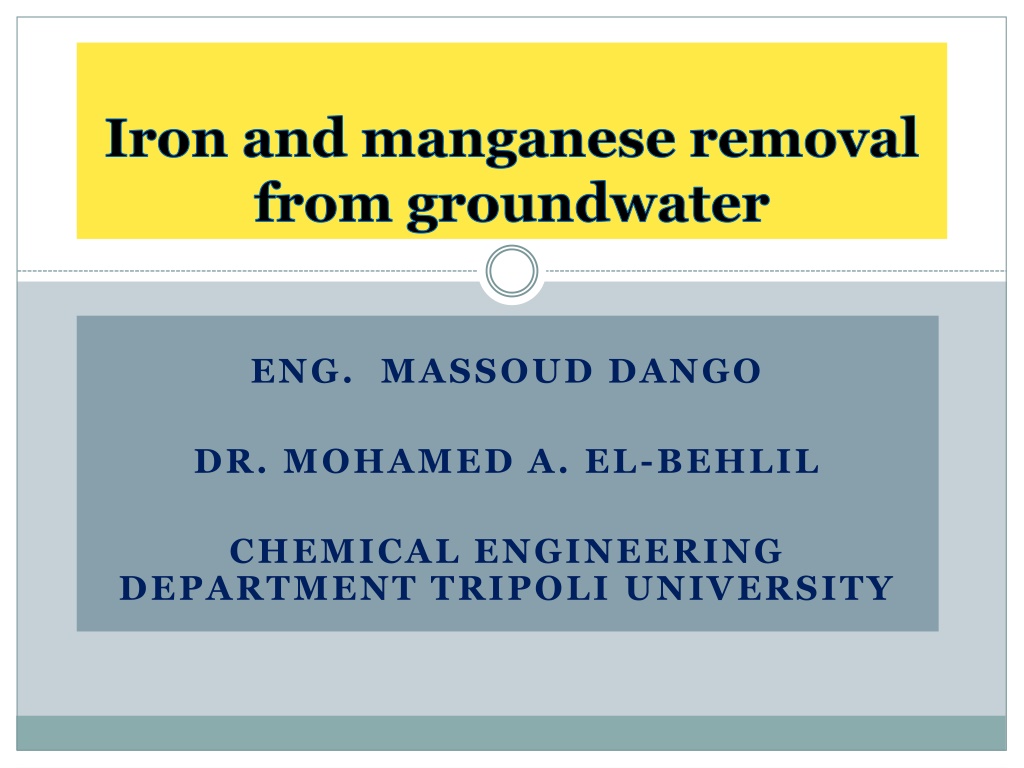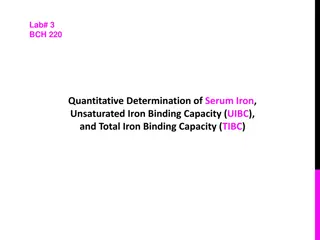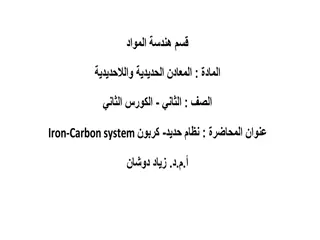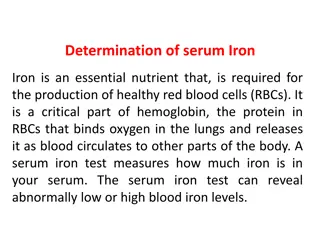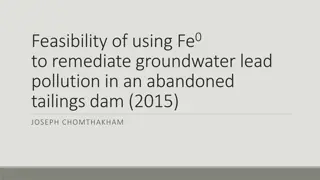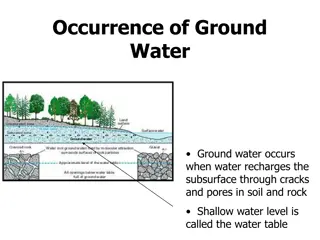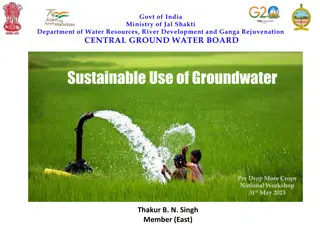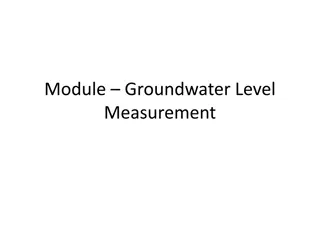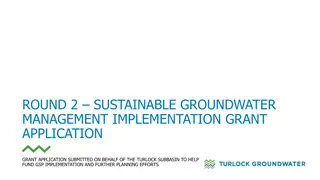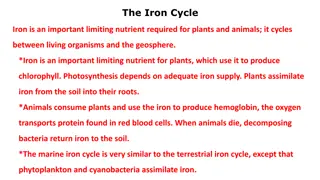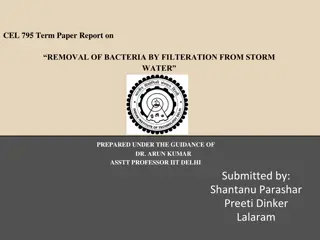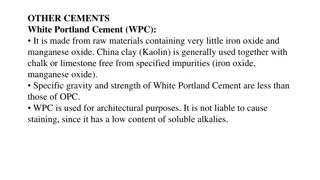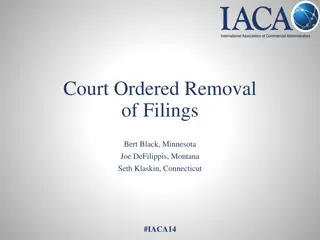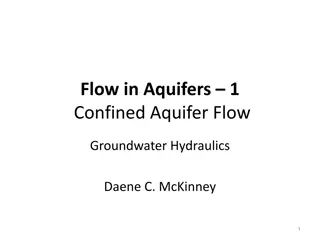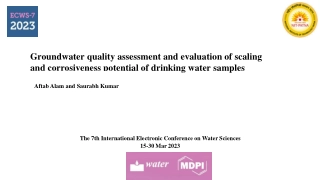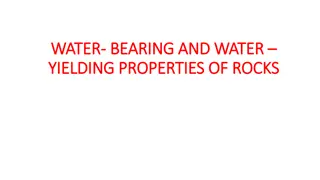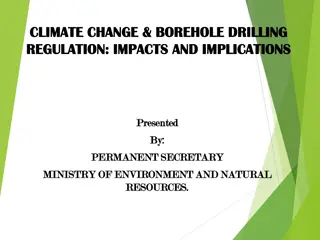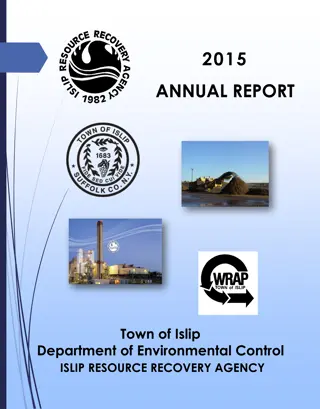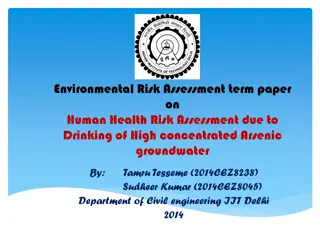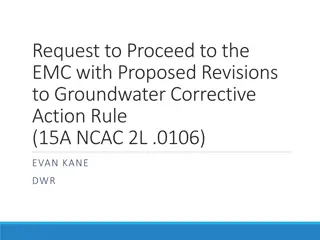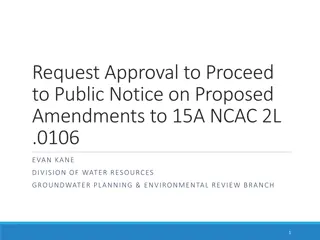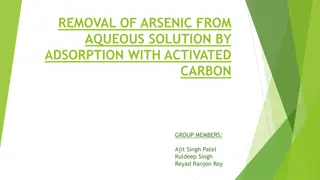Iron and Manganese Removal from Groundwater Study
Iron and manganese are common natural elements in groundwater, but their presence can lead to various issues such as metallic taste, staining of clothes and fixtures, and growth of iron bacteria. This study aims to analyze groundwater wells in Libya, identify high levels of iron and manganese, and propose effective treatment systems for removal. Oxidation/filtration processes are commonly used for treatment. The research objectives include selecting wells, analyzing water quality, and designing cost-effective treatment methods.
Download Presentation

Please find below an Image/Link to download the presentation.
The content on the website is provided AS IS for your information and personal use only. It may not be sold, licensed, or shared on other websites without obtaining consent from the author. Download presentation by click this link. If you encounter any issues during the download, it is possible that the publisher has removed the file from their server.
E N D
Presentation Transcript
Iron and manganese removal from groundwater ENG. MASSOUD DANGO DR. MOHAMED A. EL-BEHLIL CHEMICAL ENGINEERING DEPARTMENT TRIPOLI UNIVERSITY
Presentation outline Background (Formation and Impact of Fe and Mn) Objectives Treatment methods for Fe and Mn removal Fe and Mn concentrations in GW Propose a treatment system for Fe and Mn removal Oxidation reactions involved in the aeration Important design parameters Results Conclusions and recommendations
Background (Formation and Impact of Fe and Mn) Iron and Manganese Removal; Overview Iron and Manganese are natural constituents of soil and rocks. Usually natural waters have an iron content which is greater than manganese content. Waters are seldom found which have iron levels greater than 10 mg/l or manganese levels greater than 2 mg/l. Iron exists in the +2 or +3 oxidation states, whereas manganese exists in either the +2, +3, +4, +6, or +7 oxidation states. However, iron (III) and manganese (IV) are the only stable oxidation states found in waters containing oxygen.
Background (Formation and Impact of Fe and Mn) The presence of significant amounts of either or both of theses metals in a water supply can create several problems for the consumers. The problems caused by the presence of iron including: Large concentration of iron impart a metallic taste to the water. Industrial products such as paper, textiles, or leather may be discolored. Household fixtures such as porcelain basins, bathtubs, glassware, and dishes are stained.
Background (Formation and Impact of Fe and Mn) Clothes may stain a yellow or brown-yellow color. Iron precipitates clog pipes and promote the growth of gelatinous masses of iron bacteria. These bacteria slough off and create red water Iron bacteria may cause odor and taste problems, particularly, when the flow in pipes is low.
Objectives of this research The objectives of this research are: Select several GW wells in the southern part of Libya and analyze for Fe and Mn. Identify the GW source that contain higher levels of Fe and Mn exceeding the international standards. Propose and design a suitable treatment system that can be economically feasible and effective in the removal of both Fe and Mn.
Treatment methods Fe and Mn removal (cont.) What are the most common treatment processes? The majority of iron and manganese treatment systems employ the processes of oxidation/filtration. The oxidant chemically oxidizes the iron or manganese (forming a particle). The filter then removes the iron or manganese particles. Oxidation followed by filtration is a relatively simple process
Treatment methods Fe and Mn removal (cont.)
Treatment methods Fe and Mn removal (cont.)
Treatment methods Fe and Mn removal (cont.)
Treatment methods Fe and Mn removal (cont.)
Treatment methods Fe and Mn removal (cont.) Removal of Fe and Mn using aeration A low-cost method of providing oxidation is to use the oxygen in air as the oxidizing agent in a tray aerator. Water is simply passed down a series of porous trays to provide contact between air and water. Oxygen is not a strong enough oxidizing agent to break the strong complexes formed between iron and manganese and large organic molecules. Furthermore, the rate of reaction between oxygen and manganese is very slow below pH values of 9.5.
Proposed treatment system for Fe and Mn removal
Components of the proposed treatment system 1) Two completely mixed flow aeration tanks operated in series. 2) Addition of a flocculent chemical in a Flocculator with a slow mix device. 3) Plate settling tank (Lamella type) for fast separation of solids formed from oxidation reaction. 4) Dual media sand filter equipped with backwashing system. 5) Suitable disinfection system (chlorination).
Fe and Mn concentrations in GW The standards set by the World Health Organization WHO, for concentrations of Fe & Mn are 0.3, and 0.1 mg /L respectively .
Important design parameters Kinetics of Fe oxidation RXN
Important design parameters Kinetics of Mn oxidation RXN
Important design parameters Impact of pH on Fe & Mn removal
Selected GW source city of AL-Afia Brak Shati & Design data requirements Item Value population Rate of water consumption City GW consumption Flow rate to CMFR 1 Flow rate to CMFR 2 4500 inhabitants 140 L/ person-day 630000 L/day ( 630 m3/day) 110.0 L/min 327.5 L/min Water Conditions Partial pressure of oxygen Fe & Mn conversion PH for Fe reaction 42 min aeration PH for Mn reaction 50 min aeration T= 20 C & P= 1 atm 0.2 atm for Fe & 1 atm for Mn 90 % 6.9 9.5
Selected GW source city of AL-Afia Brak Shati & Design data requirements (cont.) Total oxygen required for both Fe & Mn 5.5268 mg/L Density of air at water conditions 1.205 g/L Amount of air to tank 1 2.4 L/min Amount of air to tank 2 7.5 L/min Compressed air efficiency (10 15 ) % Compressed air pressure (35 70) kN/m2
Conclusions Aeration of GW can effectively remove iron and manganese to a level accepted by local and international standards. When manganese is available in GW at higher concentrations, it is important that the water treatment process is well monitored to ensure the removal of Fe and Mn are within the acceptable levels. Manganese requires larger amount of oxygen for oxidation during aeration as compared to iron. Iron is easily oxidized than manganese during aeration.
Conclusions (cont.) Conclusions Longer retention time may be required for the removal of manganese if aeration and filtration are applied in the water treatment process. The pH adjustments need to be carefully monitored after oxidation of iron and manganese because pH may affect the floc formation and removal during the water treatment. The pH value of the effluent treated GW need to be adjusted to a level (6 8), below this level is believed to cause iron and manganese flocs formed to re- dissolve in water.
Recommendations Proposed GW treatment system for iron and manganese removal need to be tested through a pilot scale study before any field application. Further studies need to be conducted on GW that contains higher levels of Fe and Mn, Ammonium salts and natural organics matter because might have dissolved oxygen deficit. An economic study for the proposed GW treatment system for iron and manganese removal is essential for field applications in order to get cost of treatment per cubic meter.
Thanks 29
